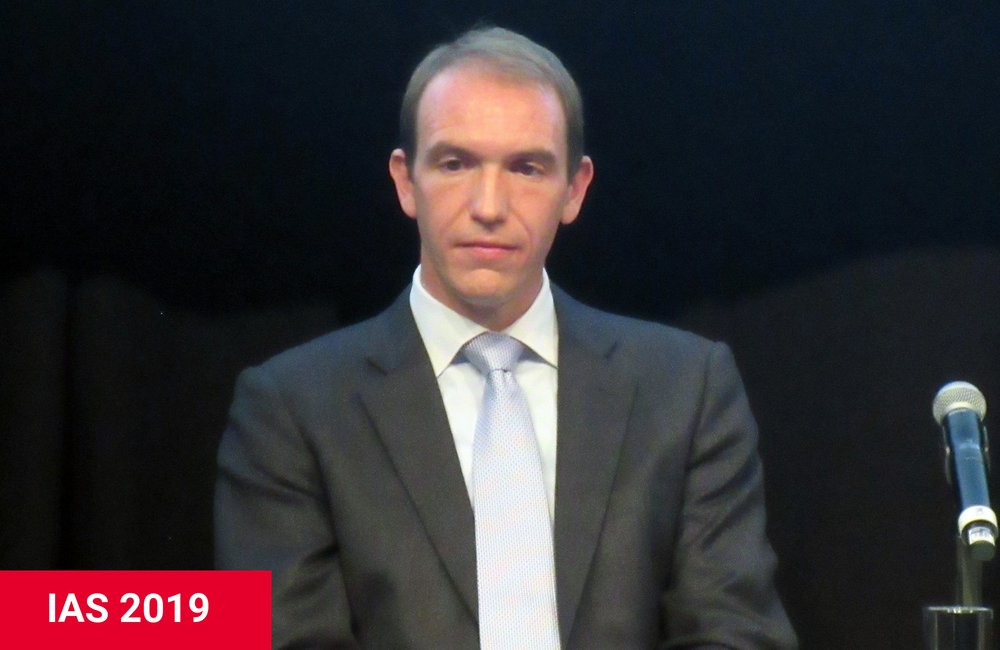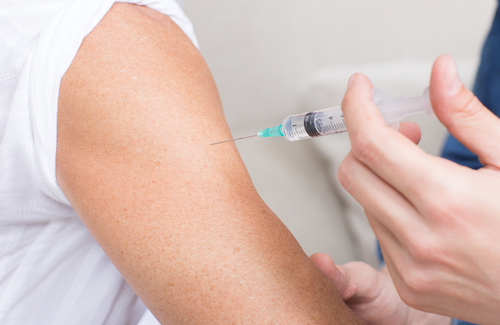
New results from a phase IIa vaccine study, APPROACH, announced today at the International AIDS Society Conference on HIV Science (IAS 2019) in Mexico City, indicate that the antibody and cellular immune responses induced by the vaccine last for at last two years, and that a protective antibody response could last for at least five years, if it declines at a rate typical of other vaccines.
Dr Frank Tomaka of Janssen, the pharmaceutical research section of Johnson & Johnson, said that even after five years, the level of anti-HIV antibodies in the blood of vaccine recipients was greater than the level seen that protected two-thirds of monkeys in pre-clinical challenge experiments. The aidsmap.com report on that result at the time noted that “we do not know how long the immunity produced by this vaccine will last", but this question has now been partly answered by the new data.
The same afternoon, another Janssen researcher, Dr Daniel Stieh, announced detailed results from a second phase IIa vaccine study, ASCENT. The results from this study have settled the question of which vaccine formulation to use in the forthcoming phase III efficacy study, MOSAICO, which will launch this autumn with 3800 gay and bisexual men and transgender women taking part in North America, South America and Europe.
The six-month results from APPROACH were announced two years ago at the IAS 2017 conference in Paris. The study's data were used to decide which vaccine to use in the first Janssen efficacy study, Imbokodo, which is under way, recruiting 2600 women in five southern and eastern African countries.
Just as important as the strength of the immune response elicited by a vaccine, however, is its duration. The first vaccine to show efficacy, RV144, for instance, would have reported 60% efficacy if the trial had been stopped after its first year. However this had declined to 31% 18 months later.
The results presented today show that the antibody response produced by the APPROACH vaccine peaked after the last inoculation in the four-injection regimen, and declined about tenfold in the first five months afterwards. Subsequently, however, it has scarcely declined any further during the following two years.
About a quarter of vaccine recipients showed no immune response to the first injection, which like the second consists of a selection of highly immunogenic HIV genes wrapped in a non-pathogenic viral ‘vector’ which mimics an infection.
However, all initial non-responders in fact did respond to the second vector dose, as well as to the third and fourth doses, which consisted of viral vector boosted by raw HIV proteins.
Tomaka told the conference that modelling studies, which extrapolated the antibody response forward in time to the fifth year after the last injection, projected that the antibody titre (blood level) at that point would still exceed the average levels seen in pre-clinical monkey studies of the precursors to the APPROACH regimen, where the vaccine protected two-thirds of the animals from HIV infection.
The cellular immune response, which stimulates activity by the T-lymphocyte cells rather than antibody production, may be as important. Vaccine design is still partly a matter of guesswork and we have no correlate of immunity to predict efficacy, so achieving an immune response by both arms of the adaptive immune system is a good sign.
The T-cell response to the env gene of HIV was not as vigorous as the antibody response to the vaccine, but was still above protective levels in participants given the higher levels of booster that were taken forward into Imbokodo.
The level in the 74% of people who responded to the first vector dose was still adequate two years after the last dose, but had fallen to zero in the 26% of first-dose non-responders. This suggests that if a T-cell response turns out to be crucial to vaccine efficacy in the big trials, an additional booster a year after the first four doses may be necessary for the minority of initial non-responders.
APPROACH participants who received the two most efficacious regimens will continue to be followed-up for the next three years to see how their immune response changes over time.
It’s go for MOSAICO, as ASCENT study shows broad efficacy against viral strains
In a separate presentation, Dr Daniel Stieh presented the final results of ASCENT, one of the other dose- and regimen-finding studies that have contributed to the vaccine that will be trialled in the MOSAICO study.
The APPROACH and Imbokodo vaccines are designed to work against clade C, the most common variety of HIV in Africa. The most common variety in men who have sex with men, worldwide, is clade B, and the aim of ASCENT was to broaden the applicability of the Janssen vaccine so that it would produce useful responses in people with non-C varieties of HIV.
It did this by splitting the booster dose into two booster doses of half the size, rather than one booster dose, in the third and fourth inoculations – one to clade C, and one to a ‘mosaic’ of various HIV antigens from other viral clades (hence MOSAICO’s name).
The ASCENT vaccine was given to 152 people, including 90 women, in the US, Rwanda and Kenya. There had been concern that by halving the clade C booster dose, the immune response to that virus would be weaker.
However there was no sign of the antibody response to clade C being any weaker than to other viral strains, either in its direct cell-killing ability or its ability to summon T-cells to destroy infected cells. The T-cell response directly stimulated by the vaccine, which was almost entirely a CD4 rather than CD8 response, was a little weaker to clade C than to the consensus pool of viruses generally, but adequate in the majority of recipients, and it may be the ability of the antibody response to mobilise the T-cell response that is more important.
We have seen vaccine studies before where strong immune responses did not translate into protection, but, Stieh commented, we know a lot more now about how varied and potent the immune response has to be to generate efficacy against HIV.
Results from Imbokodo are expected in late 2022 and from MOSAICO in late 2023.
Tomaka F et al. Two-year post-vaccination follow-up from APPROACH: Phase 1/2a randomized study evaluating safety and immunogenicity of prophylactic HIV vaccine regimens combining Ad26.Mos.HIV and gp140 envelope protein. Tenth International AIDS Society Conference on HIV Science, Mexico City, abstract TUAA0101, 2019.
View the abstract on the conference website.
Stieh DJ et al. ASCENT: Phase 2a, randomized, double-blind, placebo controlled study evaluating safety and immunogenicity of two HIV-1 prophylactic vaccine regimens comprising Ad26.Mos4.HIV and either clade C gp140 or bivalent gp140i. Tenth International AIDS Society Conference on HIV Science, Mexico City, abstract TUAC0402LB, 2019.

